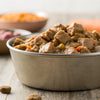How Much Wet Food Does My Dog Need? A Comprehensive Guide to Canine Nutrition
- Houndsy
Table of Contents
- Introduction
- The Importance of Proper Feeding for Dogs
- Understanding Feeding Guidelines for Canned Dog Food
- Calculating the Right Amount of Canned Food Based on Your Dog's Weight
- Considerations for Mixing Canned and Dry Food
- Adjusting Feeding Based on Life Stages and Health Needs
- Conclusion
Introduction
Did you know that roughly 59% of dogs in the United States are classified as overweight or obese? This alarming statistic stresses how crucial it is for us as pet owners to understand our dogs' nutritional needs and feeding requirements. One of the most common dilemmas we face is determining how much wet food our dogs actually need. Proper portion control not only plays a significant role in our pets' health but also in their overall well-being.
In this blog post, we will delve deep into understanding how much wet food your dog needs based on their weight, size, age, and activity level. By the end, you will have the knowledge necessary to make informed decisions, ensuring your furry friend leads a healthy and happy life.
We'll cover the following key points:
- The importance of proper feeding for dogs
- Understanding feeding guidelines for canned dog food
- How to calculate the right amount of canned food based on your dog's weight
- Considerations for mixing canned and dry food
- Adjusting feeding based on life stages and health needs
Let’s get started and enrich our feeding routines with the right knowledge!
The Importance of Proper Feeding for Dogs
Feeding your dog the right amount of food goes well beyond simply filling their bowl. Understanding proper portion sizes directly influences their long-term health, dietary balance, and weight management. Overfeeding can lead to obesity, which is associated with various health problems that may significantly shorten your dog's life. These issues include diabetes, joint problems, and heart diseases, all of which can become substantial health concerns in overweight dogs.
On the other hand, underfeeding poses its challenges. Dogs may suffer from nutritional deficiencies, resulting in low energy levels, poor coat condition, and susceptibility to illnesses. As responsible pet owners, it is our duty to find the right balance in their diet.
At Houndsy, we advocate for systems that simplify the feeding ritual, such as our Houndsy Kibble Dispenser. Designed to provide perfect portion control, our dispenser ensures that every meal is a step towards better health for your beloved pet.
Understanding Feeding Guidelines for Canned Dog Food
When deciding how much wet food to feed your dog, feeding guidelines play a pivotal role. The quantity often varies based on the specific canned food formulation, but there are general recommendations available that can guide you.
For most wet dog foods, general feeding recommendations involve giving:
- Under 10 pounds: 1/4 to 1/2 can per day
- 10 to 20 pounds: 1/2 to 1 can per day
- 20 to 40 pounds: 1 to 1.5 cans per day
- 40 to 60 pounds: 1.5 to 2 cans per day
- 60 to 80 pounds: 2 to 2.5 cans per day
- 80 to 100 pounds: 2.5 to 3 cans per day
These guidelines are not set in stone and should always be adjusted based on your dog's activity levels and specific dietary needs. You may also observe that different brands have different caloric densities, which can significantly affect the feeding amounts prescribed on their labels.
Calculating the Right Amount of Canned Food Based on Your Dog's Weight
To effectively determine how much wet food your dog needs, it’s essential to start with their ideal body weight. This is particularly important if your dog is currently overweight.
Here’s a step-by-step guide to sizing their portion accurately:
-
Determine Your Dog’s Ideal Weight: Consult your veterinarian to understand what weight would be healthy for your dog, taking into consideration their breed, age, and any health conditions.
-
Check the Feeding Guidelines: Refer to the feeding guide on the wet food can to understand how much your dog should be eating based on their weight.
-
Calculate Daily Portions: Use the guidelines to calculate how much food to provide daily. For instance, if your dog weighs 30 pounds and requires one can per 15 pounds, you’d need to feed them 2 cans per day.
-
Divide Into Meals: If feeding twice daily, split the total amount of food into their meals. For 2 cans per day, this would equate to 1 can per meal.
-
Monitor and Adjust: Regularly weigh your dog and keep an eye on their overall health. Should any shifts in weight occur, consult your vet for potential modifications in their diet.
Example Calculation
Let’s say you have a 50-pound dog. Generally, they need about 1.5 to 2 cans of food per day. If we select the midpoint of 1.75 cans:
- Daily Total: 1.75 cans
- Per Meal: Approximately 0.875 cans (or about 7/8 can)
Following this systematic approach allows for a better understanding of how much to feed your dog, maintaining a consistent and healthy feeding routine.
Considerations for Mixing Canned and Dry Food
More and more pet owners are choosing to mix canned and dry food to provide their dogs with a varied and enjoyable dining experience. This method has its benefits, including improved palatability, enhanced hydration, and a broader spectrum of nutrients.
How to Mix Canned and Dry Food
-
Adjust Portions: If you’re adding canned food, reduce the amount of dry food accordingly. A good rule of thumb is to decrease the dry food portion by 1/3 cup for every half can of wet food you add.
-
Monitor Caloric Intake: Always ensure that the combined caloric value of the mixed foods aligns with your dog’s required intake.
-
Experiment with Ratios: Every dog is uniquely different. You may find that your pet enjoys certain ratios that work better for them in terms of flavor and satisfaction.
Benefits of Mixing
- Increased Appeal: Wet food can entice even the pickiest eaters, making mealtime more enjoyable.
- Better Hydration: The high moisture content in wet food contributes to overall hydration, which is particularly beneficial for dogs that may not drink enough water.
- Nutritional Variety: Mixing different food types allows for a broader range of protein sources, vitamins, and minerals, supporting better health.
Adjusting Feeding Based on Life Stages and Health Needs
As our canine companions grow, their nutritional needs evolve significantly. It’s important for us to adapt their diet accordingly.
Puppies
Puppies typically require more calories and nutrients to support their rapid developmental stages. You may find that feeding them two to four times the amount of wet food based on their weight will ensure proper growth. Always consult your vet for tailored recommendations for your puppy’s specific breed and size.
Adult Dogs
For adult dogs, maintaining a consistent feeding schedule that resonates with their energy levels and lifestyle is crucial. Active dogs may require more food than those with a sedentary lifestyle, so adjust their portions accordingly.
Senior Dogs
Senior dogs generally require fewer calories due to reduced activity levels. Look for senior-specific formulas that are lower in calories but high in nutrients. Monitor their weight and health closely, adjusting their food intake as needed.
Conclusion
Understanding how much wet food to feed your dog is vital for their health and longevity. Armed with the guidelines discussed in this post, you can ensure your beloved pet receives the nutrition they need by tailor-fitted portion control. As dedicated pet parents, it’s our responsibility to enrich their lives by simplifying the feeding process.
We at Houndsy are committed to making dog feeding a joyful and stress-free experience. Our Houndsy Kibble Dispenser offers perfect portion control while enhancing your home’s decor. If you're ready to elevate your dog feeding experience and ensure you provide your pet with the perfect portions, consider checking out our dispenser here.
FAQ
-
How do I know how much canned food to feed my dog?
Start by checking the feeding guidelines on the canned food label based on your dog's weight. Adjust for their activity level and consult your vet for personalized recommendations. -
Can I mix canned food with dry food?
Yes, mixing canned food with dry food can enhance palatability and provide additional hydration. Just be sure to adjust portions to avoid overfeeding. -
How many meals should I feed my dog each day?
Most adult dogs thrive on two meals per day, while puppies may need three to five meals, and senior dogs typically do well with two meals. -
What if my dog is overweight?
If your dog is overweight, consult your veterinarian to develop a weight management plan that includes appropriate feeding amounts and exercise. -
Are there any specific dietary needs for senior dogs?
Senior dogs may require lower calorie foods and those enriched with joint-supporting nutrients. Always consult your veterinarian for tailored dietary recommendations.












